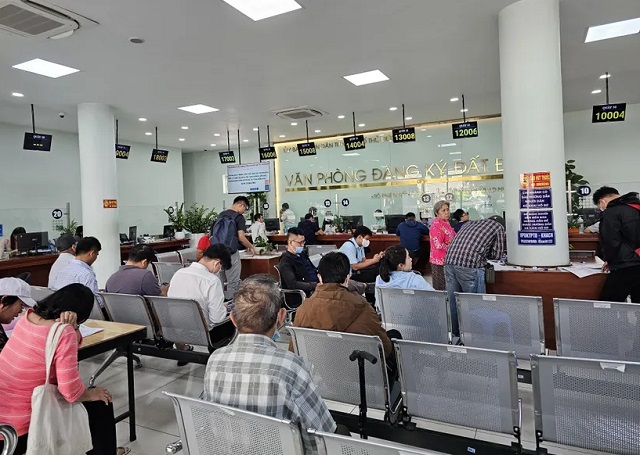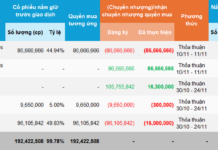
Citizens processing land procedures at the Thu Duc Land Registration Office Branch.
|
Maintaining Offices Under the Department
According to the Land Management Department, all 34 provinces and cities have established 703 land registration offices directly under the Department of Agriculture and Rural Development (DARD).
Reports from local authorities indicate that before the 2024 Land Law took effect, the total number of civil servants and employees across the entire land registration system nationwide was 16,683. Of these, approximately 12,600 staff members were based at branch offices.
To ensure the principle of a single tier and a single point of contact responsible for resolving land-related administrative procedures within their jurisdiction, the Land Management Department proposes maintaining the operation of land registration offices under the DARD. This would unify the tasks of building, updating, managing, and operating the land database; delivering land-related public services; and supporting state management functions within the province’s jurisdiction. Additional tasks would be incorporated to ensure connectivity and appropriate data usage permissions aligned with the two-tier local government model.
Transferring Branches to Wards and Communes
In its proposal, the Land Management Department recommends transferring the authority and responsibilities of branch offices to the commune level. This would involve ending the operations of existing branches and legally transferring their authority and functions to the commune level.
The department’s proposal outlines two options:
Option 1: Commune-level People’s Committees would establish public service units to assume the authority and responsibilities of branches as currently defined by law.
Based on population size and economic scale, provincial People’s Committees would assign a minimum of two branch staff members per commune, ward, or special zone. This option maintains a structure similar to the existing model, facilitating operations and financial mechanisms due to established regulations.
However, potential drawbacks include possible bureaucratic expansion; limited support for state land management due to two units at the same level performing similar tasks; and inconsistent authority regarding certificate issuance under commune-level chairpersons.
Option 2: Transfer authority for certificate issuance and change confirmation (for registered land alterations within branch jurisdiction) to commune-level People’s Committee chairpersons. Based on local conditions, these chairpersons could delegate this authority to commune-level land management agencies.
Transfer branch functions to commune-level land management agencies, ensuring a single responsible body for handling land procedures for citizens and businesses. Based on population size and economic scale, provincial People’s Committees would assign a minimum of two branch staff members to commune-level land management agencies.
This option unifies and ensures the principle of a single tier and agency for land matters within commune jurisdiction, as legally defined; promotes leaner operations and reduced coordination points; encourages modern technology use in land management; and minimizes inconvenience and negativity for citizens and businesses.
However, challenges include difficulties in operational and financial mechanisms when adding public service tasks, particularly regarding the integration of civil servants and contracted employees from branch personnel.
The Land Management Department’s Party Committee considers Option 2 the most suitable and feasible choice, meeting government requirements for streamlined organization, enhanced decentralization to local authorities, and adherence to the “one tier, one agency” principle for unified land registration tasks.
Trà Giang
– 07:00 10/10/2025
Ultimate Data Cleansing for Real Estate
The Ministry of Agriculture and Environment is racing to cleanse data for 49.7 million land plots, while the Ministry of Construction is accelerating the upgrade of its housing information system. Both agencies are intensifying their efforts to “purify” data within this year.
The Industrial Park Ultimatum: A 49-Ha Behemoth Stalls in Thanh Hóa
The People’s Committee of Thanh Hoa province has issued a decision to adjust the implementation schedule for the technical infrastructure construction project at Khe Ha Industrial Cluster, located in the former Luong Xuan district’s Luon Thanh commune. The project investor is Truong Son Technical Infrastructure Construction Investment Joint Stock Company.
34 Civil Servants from the Ministry of Agriculture and Rural Development Descend to Localities to Streamline Land Procedures for the Two-Tier Government Implementation
“A team of 34 highly skilled civil servants from the Ministry of Natural Resources and Environment have been dispatched to offer their expertise and support in land-related matters at the local level. These professionals will be working closely with local authorities to ensure efficient and effective management of land resources, bringing with them a wealth of knowledge and experience in this vital field.”
34 Civil Servants from the Ministry of Agriculture and Rural Development Deployed to Localities to Streamline Land Procedures for the Implementation of the Two-Tier Government
“A team of 34 skilled officials from the Ministry of Agriculture and Rural Development have been strategically deployed to offer their expertise at the local level. These professionals are tasked with providing much-needed support and guidance in the crucial realm of land management, ensuring efficient and effective solutions are implemented.”













































